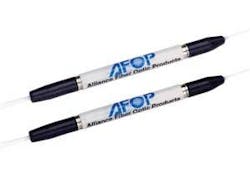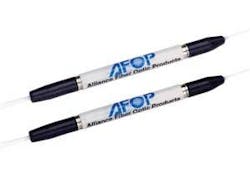AWGs, TFFs find market niches
By Meghan Fuller
Much like the overall optical communications industry, the WDM filter market has experienced highs and lows since the first components were deployed in systems in 1996. Thin-film filters (TFFs) appeared first but, at various points over the last 10 years, seemed destined for obsolescence as arrayed waveguide grating (AWG) technology looked to be the more cost-effective option. However, both have retained their relevance in a market where cost is sometimes valued over performance and vice versa.
AWGs came to prominence during the optical boom, when system vendors were trying to pack as many channels into their systems as possible. Because of their structure, AWG filters are sold in 40-channel increments, making them ideal for high-channel-count applications. “In the beginning of 2001, it looked like AWGs were going to take over completely,” recalls G. Ferris Lipscomb, vice president of marketing at NeoPhotonics (www.neophotonics.com), a manufacturer of AWGs. “But then came the bust, and in the bust, people’s dreams of actually selling 40, 80, and 160 channels evaporated.”
What mattered next was a low first cost, and many systems vendors adopted a pay-as-you-grow approach to system design, which gave TFF technology a new lease on life, says Lipscomb. A new system might be deployed with four channels, for example, and when additional channels were needed, another four-channel block was deployed. And it didn’t matter that by the time a carrier had deployed 40 channels, it had spent much more-sometimes as much as four or five times more, says Lipscomb-than if it had deployed an AWG from the outset. During the market downturn, carriers only deployed channels when there was actual traffic and revenue to support them. Carriers may have paid more for additional channels, but they could pass that cost on to the customer.
“So instead of having high-channel-count AWGs take over in the 2001 timeframe, the two camps continued in parallel,” confirms Lipscomb.
To some extent, that is exactly where the industry remains today. According to Daoyi Wang, senior optical engineer at Alliance Fiber Optic Products (www.afop.com), it is not simply a case of either/or; both technologies have established their niche in the WDM market. Generally speaking, AWGs are more cost-effective in long-haul, high-channel-count DWDM applications, he says. TFFs, by contrast, are ideal for use in low-channel-count CWDM-type metro applications. All the sources interviewed for this story listed 16 channels as the benchmark; fewer than 16 channels is the sweet spot for TFF technology, while AWGs are optimized for applications with more than 16 channels.
This division within the WDM filter space has as much to do with economics as performance, though it’s important to note that the cost of both technologies has fallen dramatically. In the 1998 timeframe, says Lipscomb, a TFF cost around $1,000 per channel, while an AWG might run $20,000 per channel, due to the complexity of manufacturing the devices and the resultant low yields. Today, Lipscomb says the cost of AWGs in high volume is less than $20 per channel. “That has caused even more of a shift to AWGs,” he reports. “It’s not as big a barrier to deploy that AWG upfront because the costs are so much less.”
Jy Bhardwaj, general manager of agile optical networks at JDSU (www.jdsu.com), notes that his company does not usually comment on specific price points, though he did confirm that “in terms of the rate of decline, those numbers are fairly reasonable.” (JDSU manufactures AWGs.)Not everyone agrees, however. “I’ve never heard of an AWG under $20,” contends Giovanni Barbarossa, chief technology officer at Avanex, which makes TFFs. “Though I have heard about $25 to $30,” he says. In the case of TFFs, Barbarossa admits the price is slightly higher, but only because TFFs provide “a different type of economy. The AWG manufacturers make money because they sell 40 channels at once,” he says. “In our case, we sell two, four, eight, and maybe 16. The packaging and all the overhead from a product perspective has to be distributed among a much lower number of channels, and that’s why the price is higher.”
For this reason, AWGs are more cost-effective for higher-channel-count applications; as the channel count increases, the cost per channel decreases. The opposite is true for TFFs. The most expensive part of the device is the thin film itself, and TFFs must be cascaded, one after another, to achieve the requisite number of add/drops. As such, the price of the TFF scales upward with the number of channels. “That’s why when you go to 16 channels, you run out of gas and have to switch to AWGs,” Barbarossa admits.That said, TFFs are more economical at lower channel counts, despite having a higher per-channel cost. The biggest advantage of the TFF is its per-wavelength or per-channel granularity; you can use one TFF for a single add/drop. AWGs, by contrast, do not scale. “With AWGs,” says Wang, “you get all 40 channels. You cannot choose only two, three, or four. Therefore, if you only wanted 10 channels, it’s the same cost as 40 channels. But with filter technology,” he adds, “if you want to buy four channels, the price is much lower than eight channels.” AFOP’s filters employ TFF technology, though the thin film is sourced from outside suppliers.
Beyond channel count, each technology also provides its own advantages at a given channel spacing. “At 200 GHz, for example, the number of channels in the C-band is limited,” notes Bhardwaj, “and, therefore, low-cost TFFs tend to dominate that space. Very few AWGs use a 200 GHz [channel spacing], if any,” he adds.
AWG technology, meanwhile, has found a sweet spot in 50-GHz DWDM systems, which typically support higher data rates that are more sensitive to signal degradations. “For example, 10G is more demanding of chromatic dispersion than 2.5G,” says Bhardwaj, “And 40G is even more demanding. The chromatic dispersion in the device is actually driven by the group delay ripple, and the group delay ripple in AWGs is inherently lower than in thin-film filters,” he reports.
Understandably, both camps are bullish on the superiority of their technology. The AWG manufacturers will tell you that the introduction of athermal AWGs enables the technology to replace TFFs, which are athermal by nature, on shelves without power-at least at 100 GHz. Moreover, they’ll point to the integration capabilities of the AWG as an attractive feature going forward. Lipscomb confirms that NeoPhotonics manufactures reconfigurable optical add/drop multiplexers (ROADMs) that integrate AWG filters, switches, variable optical attenuators (VOAs), and monitoring taps, thus lowering the overall system cost.
The TFF manufacturers, in turn, will say that their devices are more easily upgradeable. “When we package thin-film filters,” says Barbarossa, “we can always make the last port of the last filter available for an upgrade port. And there are strategies to make sure that when you upgrade, the express path loss is balanced.”
At the end of the day, admits Barbarossa, it’s often a matter of the system vendors’ almost religious preference for one over the other. “Some companies historically always use the thin-film filter, and some companies have always used AWGs. Sometimes, people get comfortable with one solution, and they just keep using it,” he says.Meghan Fuller is senior editor at Lightwave.


